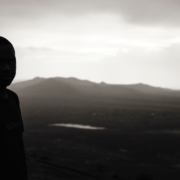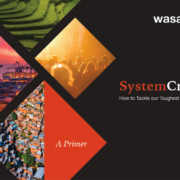This week we have a guest blogger – Griff Griffiths, who shares some thoughts on wicked problems and complexity thinking, taken from beyond the world of international development.
Griff runs Cocomotion, works in the complex area of People and Organizational Development and describes himself as a ‘surprisingly useful person.’ He has been working, thinking and experimenting with the application of complexity thinking for longer than Wasafiri has existed; and has found himself in the midst of everything from large scale IT projects, to working with young people in Gaza, alongside a whole host of corporate world adventures.
I met Griff during a partially successful experiment to get a whole group of people to imitate a flock of birds – and he filled my head with all sorts of ideas about complexity from a world outside of international development. So, I thought we would invite him along to add some new ideas, perspectives and background to some of thinking we have been exploring at Wasafiri over the last few months.
How do we get to grips with wicked issues?
Our most intractable problems are hard to fix because they contain many more factors than we can hope to count, understand or control; because the factors are interdependent in ways we cannot always discern; and because small changes sometimes have big effects, and vice versa. And when we do fix these problems, they don’t stay fixed. These are the so-called wicked problems and we have many of them, at all scales of human interaction – societies, communities, organisations and groups; between individuals and within individuals.
We could be better at solving them, but we’ve been focussed on other problems for quite a long time, like going to the moon or flying to Europe for twenty five pounds, which are very complicated, but for which we’ve developed sophisticated and successful techniques of planning and control. Now our wicked issues are beginning to bite hard.
So what can we do? Here are some ideas:
Change the way we think about the world
In their wonderful 2015 overview of wickedness Embracing Complexity: Strategic Perspectives for an Age of Turbulence, Boulton, Allen and Bowman make the case for complexity as a worldview. They point out that the mindset that this involves – seeing the world as interwoven process rather than interacting objects, or, as a friend of mine said recently, thinking of people as verbs, not nouns – is one which was common in the distant past, but has long fallen out of favour.
When we intervene in such a world, we’re confronted not only with risk, but with uncertainty – it’s not merely a question of whether our interventions will work or not, it’s that they may result in the appearance of entirely new phenomena that we can’t predict in advance. Boulton et al give the example of SMS, which was a tiny feature in the then-new digital mobile networks designed to notify users of voicemail; what it became was the conduit for an entirely unexpected global phenomenon of short interpersonal messaging, which itself reshaped the way people communicate.
Use metaphor – with care
In her 1993 paper Chaos and Complexity, What Can Science Teach? Margaret Wheatley also refers to the need for a shift in consciousness and draws rich metaphors from complexity science to illustrate how our thinking about organisations can shift from organisation-as-machine to organisation-as-complex-entity. She challenges assumptions that we commonly make about human organisations based on ideas taken from, for example, mechanics (‘change happens as the result of external influences’) and physics (‘things fall apart’ – entropy). She offers alternatives, drawn from complexity science, which describe what we see in organisations in a more useful way, and suggest different ways of working.
But although models from complexity science can help us in this way with metaphor, they can’t just be transplanted in order to explain the complexity we find in human affairs. For example, chaos can mean many things: it’s been used as a beautiful metaphor for the behaviour of flourishing teams, as an obvious metaphor for anarchy, and Wheatley talks about it as breeding self-organisation and creativity. What are we to make of that?
Search for explanations
Metaphor lets us borrow language from complexity science to describe what we see; explanation gives us insight to understand and influence. We need explanatory theories of complex human interaction to give us a basis upon which to work with wicked problems.
Glenda Eoyang (Human Systems Dynamics) and Ralph Stacey (Complex Responsive Processes) are two thinkers whose work explores the underlying dynamics of human interaction to develop theories which explain those dynamics, and show why human interaction self-organises into observable patterns. Eoyang’s work seeks to build on this to create further specific models which provide more detail for particular domains, such as community engagement or team effectiveness.
Interestingly, both Eoyang and Stacey’s theories apply at any scale of human interaction – within the individual person; in one to one interactions; within groups and in whole societies. This suggests that there might be scale free ways of working with complexity; approaches which we can use with any size of wicked problem.
Develop processes
There’s a three-minute video by Eric Berlow in another post on this blog, in which he talks about standing back, looking for patterns, choosing a sphere of influence and looking for a ‘simple detail that matters most’ as the place to intervene if we want to change things.
We are in a world of massively entangled connections. The ‘simple detail that matters most’ is quite likely a detail that also matters in some other web of connections, not just the one we are focussed on, and our actions to influence in one place may give rise to unintended consequences in another – either within our field of view or outside it.
So if we aren’t sure what the outcomes of our interventions will be, or even where or when they will occur, then we are more or less compelled to work in adaptive cycles rather than following a long term, fixed plan. What might the general features of an adaptive approach be? Look for pattern. Find the detail that matters most. Act to influence it. See if the patterns change. Look for pattern… and so on.
But working like this presents some challenges. DFID’s report From Best Practice to Best Fit, summarised in another post on this blog, notes that “While [development] programmes exhibiting best fit can readily be described at a conceptual level, they have proved rather harder to operationalise.”
Perhaps that’s partly a question of how long people have been trying. The tech industry operationalised software development to a best fit process (Agile), after years of failing to deliver on time or within budget, or even to deliver what the client actually wanted. Agile recognises that the client’s understanding of what they want emerges as the work progresses, and changes direction as a result of that understanding, and as a result of changing environmental (market) conditions during the work.
Software is much simpler than international development, but even so, it took the industry quite a few years to work out how to do it, and several different approaches have evolved under the same broad process. And despite Agile’s success, the transition to it is by no means complete, partly because of a reluctance to let go of deeply held ideas of control – a quick glance at the Agile Manifesto gives a sense of the letting-go required.
Use what we already know
Finally, it’s worth saying that adopting a complexity worldview doesn’t require a celebratory bonfire of the GANTT charts. Some situations respond well to command and control. Some things can be planned. Some can be predicted. At least for a little while!
For more information about Griff and the work that he does check out: www.griffgrifiths.co.uk








